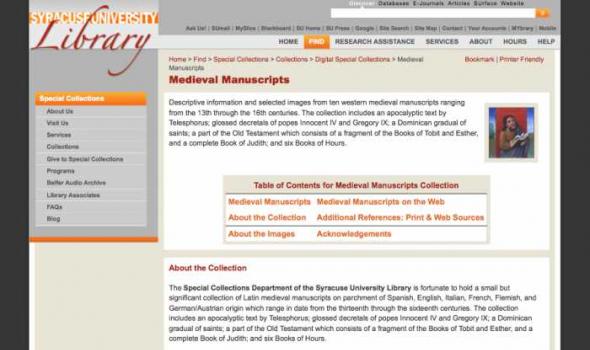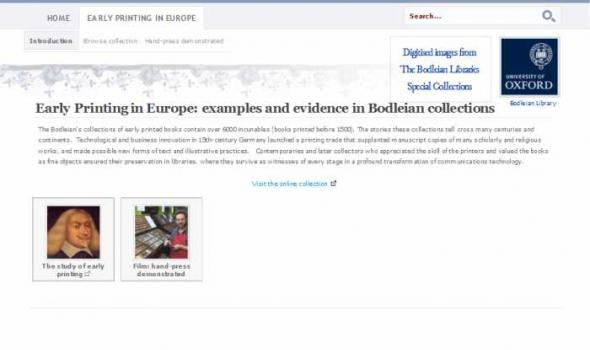Category: English, Manuscript
Results
The Collection The Beinecke Library’s Medieval and Renaissance collections document the history of human thought from the Byzantine era through 1600. The first medieval manuscript recorded in the Yale collection was acquired in 1714, and was the gift of Elihu Yale. An illustrated copy of the Speculum humanae salvationis , it attracted the special attention of Yale President Ezra Stiles, who read the manuscript and annotated it in the 1790s. The systematic collecting of medieval manuscripts at Yale, however, dates from the late nineteenth century, and the most active period for collecting was after 1930.
Medieval Manuscripts Descriptive information and selected images from ten western medieval manuscripts ranging from the 13th through the 16th centuries. The collection includes an apocalyptic text by Telesphorus; glossed decretals of popes Innocent IV and Gregory IX; a Dominican gradual of saints; a part of the Old Testament which consists of a fragment of the Books of Tobit and Esther, and a complete Book of Judith; and six Books of Hours. About the Collection The Special Collections Department of the Syracuse University Library is fortunate to hold a small but significant collection of Latin medieval manuscripts on parchment of Spanish, English, Italian, French, Flemish, and German/Austrian origin which range in date from the thirteenth through the sixteenth centuries.
The Osborne Collection Toronto Public Library’s Osborne Collection of Early Children’s Books is one of the world’s foremost historical collections of English-language children’s literature. Located in the Lillian H. Smith branch , the Osborne Collection holds over 80,000 items, including manuscripts, books, book-related art, archives, ephemera and book-related games. Our collection ranges from a 14th-century manuscript of Aesop’s Fables through medieval books of manners, moral tales of the Puritan era, 18th-century chapbooks and hornbooks to Victorian classics of fantasy, adventure, and school stories up to 1910. We also collect modern notable books published after 1910.
DIGITAL COLLECTIONS About the Collection This digital collection includes eighteen illuminated manuscript leaves which were acquired by the University of Louisville Libraries in 2006 with funding from the Pzena Foundation. Dating from 1150 through 1867, these leaves represent Western European and Islamic cultures. Lesson plans mapping to Kentucky Education Reform Act (KERA) Core Content goals for the 7th grade Arts & Humanities curriculum supplement the online presentation.
Home Medieval and Renaissance Manuscripts Digitised images from The Bodleian Libraries Special Collections Bodleian Library Search: Medieval and Renaissance Manuscripts (from 35mm) Browse the collection Around 25,000 images selected mostly from Western illuminated manuscripts (with a few from early printed books) and scanned from the Bodleian's older image library of 35mm slides and
Digitised images from The Bodleian Libraries Special Collections Search: Masterpieces of the non-Western book The Bodleian has had unusual opportunities to acquire, through the activities of collectors in the 17th, 18th, and 19th centuries, a wide range of pictorial material produced in and relating to Asia, the Near East, and South Asia. The Hebrew, Islamic, and South Asian collections are particularly rich in fine illustrated and illuminated manuscripts. Islamic Collections The Bodleian’s Islamic collections include many fine examples of Arabic and Persian manuscript ornamentation.
Digitised images from The Bodleian Libraries Special Collections Search: Early Printing in Europe: examples and evidence in Bodleian collections The Bodleian’s collections of early printed books contain over 6000 incunables (books printed before 1500). The stories these collections tell cross many centuries and continents. Technological and business innovation in 15th-century Germany launched a printing trade that supplanted manuscript copies of many scholarly and religious works, and made possible new forms of text and illustrative practices.
About the Stevens Family Papers This is a collection of correspondence and other papers relating to Robert S. Stevens' work as manager of the Missouri, Kansas, and Texas Railway and the Hannibal and St. Joseph Railroad, and to his investments in Kansas lands. This collection is dated from 1805 - 1899. For more information, go to the Guide to the Stevens Family Papers . For additional information about Cornell University Library's Archival Guides, go to the Guides for Archival and Manuscript Collections . For reference questions, please complete our reference form . For feedback about this website, contact rmcweb@cornell.edu .
The Saganet is a cooperative project by The National and University Library of Iceland and Cornell University with the association of the Árni Magnússon Institute to give access via the Internet to digital images of about 240.000 manuscript pages and 153.000 printed pages. The Saganet was opened on July 1, 2001 but work started on July 1, 1997.
About the Project Named after the pioneering critic of the commercialization of mass media, the late Professor Rose Goldsen of Cornell University, the Archive was founded in 2002 by Timothy Murray to house international art work produced on CD-Rom, DVD-Rom, video, digital interfaces, and the internet. Its collection of supporting materials includes unpublished manuscripts and designs, catalogues, monographs, and resource guides to new media art.
This site presents digital reproductions of images from the University Archives and from rare books and manuscripts held by the Cornell University Library. The images are delivered via Luna Insight® image browser . Please adjust your browser to allow pop-up windows before attempting to launch the collection. If you continue to experience technical difficulties, please report your problem to vrhelp-l@cornell.edu . For reference questions, please complete our reference form . For questions or comments about this website, send E-mail to rmcweb@cornell.edu .
Last updated: 14 January 2009 The Loss and Recovery of Greek Medicine in the West After the fall of the Roman Empire in the 5th century, most works of the Greek physicians were lost to Western Europe. In the 14th and 15th centuries, however, Western Europeans began to rediscover Greek scientific and medical texts. This was due in part to the discovery of Arab repositories of learning in Spain and elsewhere during the Crusades as well as the immigration to Italy of Byzantine scholars at the fall of Constantinople in 1453.
Medieval Islam Islamic cultures are among the most interesting, complex, and dynamic in the world. At the same time, they are among the least known in the West. From its dramatic rise in the seventh century A. D. to the present, Islamic civilization has covered a large part of the globe, incorporating many subcultures and languages into its orbit, and vigorously engaging the peoples around it. Medicine was a central part of medieval Islamic culture. Disease and health were of importance to rich and poor alike, as indeed they are in every civilization. Responding to circumstances of time and place, Islamic physicians and scholars developed a large and complex medical literature exploring and synthesizing the theory and practice of medicine.
History of Medicine Robert Hooke (1635-1703) was a remarkably versatile man — artist, biologist, physicist, engineer, architect, inventor, and more. However, his crowning glory was Micrographia: or Some Physiological Descriptions of Minute Bodies made by Magnifying Glasses , first published 1665. It was a masterpiece — an exquisitely illustrated introduction to the previously unknown microscopic world. This exhibit focuses on Hooke's influences and legacy in print, the pioneering books that stimulated Hooke's research, and the works he left for others — most famously the great Dutch microscopist, Antoni van Leeuwenhœk (1632-1723). August 1 – November 1, 2007.
History of Medicine Introduction The National Library of Medicine's Bathtub Collection is an archive of materials found in the old bindings when rare books in the Library were conserved. The materials found in the bindings include fragments of old printed books or manuscript materials which are often treasures on their own. In the Bathtub Collection, NLM has organized and described these fragments and made them available to scholars. The story of the Bathtub Collection begins in the middle of the last century. In the 1940's, The Army Medical Library, as the National Library of Medicine was then known, began a serious conservation program for its rare book collection. The AML hired Dorothy Schullian as curator of rare books and Jean Eschman, a master bookbinder from Switzerland.
Medicine in the Old World arose from many components: the classical Greek tradition, its Christian re-elaboration, the contributions of the Arabic World, and the unique medieval synthesis of them all. By examining significant pages and illuminations from manuscripts and early printed books of the National Library of Medicine, one can see how these cultures contributed to the creation of medical knowledge in Europe.
These pages are a journey through time and space, as medical knowledge moved around and across the Mediterranean Sea. Mare nostrum—Our Sea—divided societies into several groups, but it could be crossed, making cultural contact, trade, and the exchange of ideas possible.
Site developed & hosted by Center for Digital Scholarship Brown University Library Providence, RI 02912 The Minassian collection and its holdings of early Qur’an folios This database catalogues the holdings of over 200 Qur’anic manuscript folios dating from the 9th to the 16th centuries housed within the special collections of the Brown University libraries. These items were acquired as part of a treasury of rich artistic and textual items donated in 1998 to Brown by Adrienne Minassian, the daughter of Kirkor Minassian (1874–1944), who was an active art collector and dealer based in New York and Paris in the early 20th century.
About This Collection The Hay Library’s famed collection of manuscripts authored or signed by Lincoln, now comprising nearly 1,100 pieces in all, represents the accumulation of many years of active collecting by private individuals and Friends of the Brown University Library. These materials came to the Library in a number of ways. The original core of the collection included 134 manuscripts by Lincoln and another 183 by close associates of Lincoln. These materials came to the Library in 1923 as part of the Lincoln collection compiled by Charles Woodbury McLellan, one of the five great Lincoln collectors in the early 20th century. Since then, manuscripts have been added both by gift and by purchase. The first major addition to the collection was made by John D.
Interest in the Middle East and the Islamic world is at an all time high, generating a corresponding increase in demand for specialized teaching, learning and transmitting critical knowledge and perspectives on this part of the world. Understanding this region involves learning about the social, political, religious and cultural issues – past and present – that shape the Islamic world of today. Studying Middle Eastern cultures and peoples across all time periods provides a crucial framework for understanding the complex relationship between Islam and the West today.
Polar Bear Expedition Digital Materials Because many of the American troops involved in the intervention were from Michigan, the Bentley Historical Library Michigan Historical Collections has long been interested in documenting this episode. This collection contains digitized versions manuscripts and photographs as well as maps and primary printed source materials relating to the Polar Bear Expedition. The primary guide to the Polar Bear Expedition collections held by the Bentley Historical Library can be found here: Polar Bear Expedition Digital Collections .









































